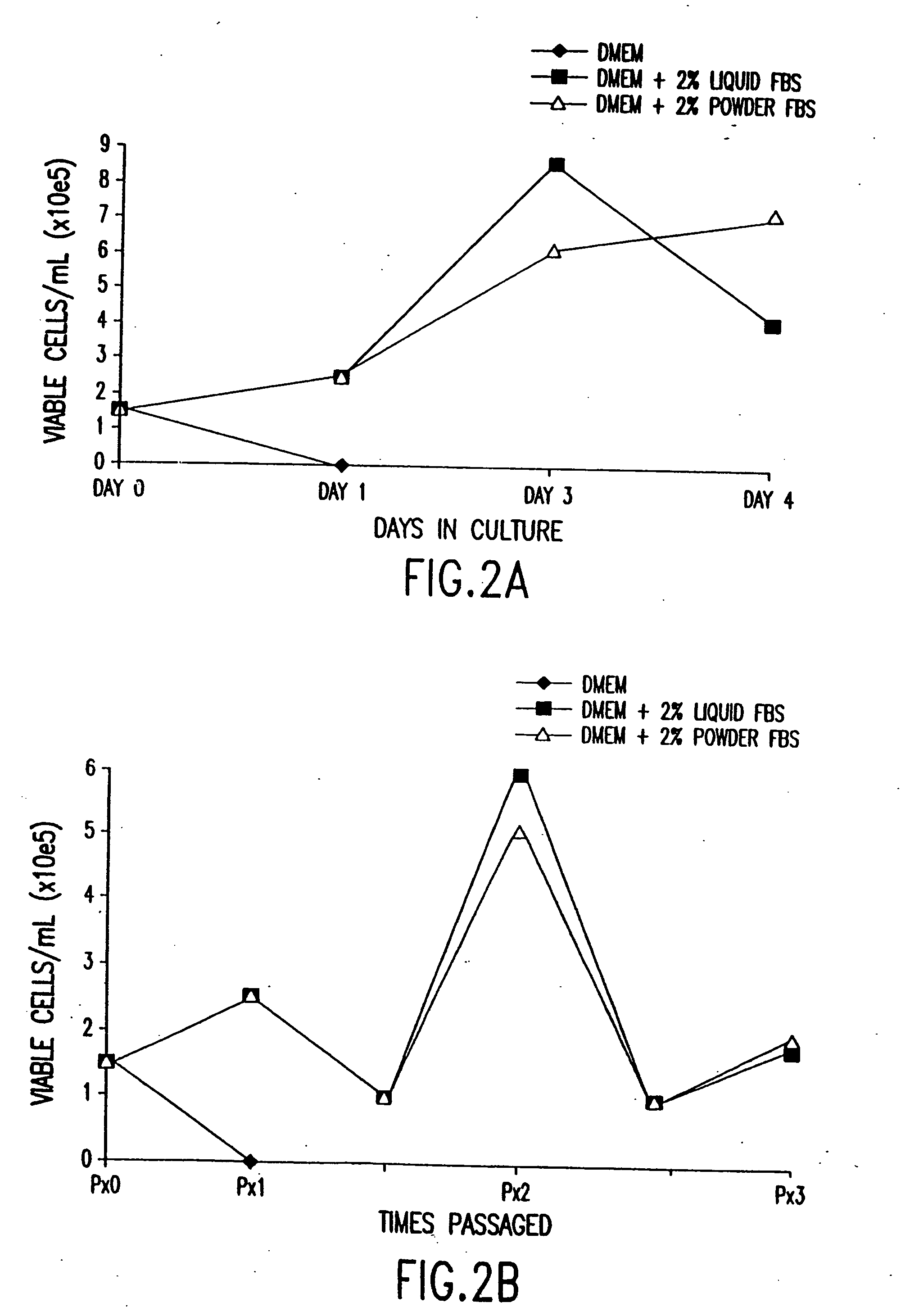Dry powder cells and cell culture reagents and methods of production thereof
a technology of cell culture which is applied in the field of dry powder cell culture reagents and cell culture reagents and methods of production thereof, can solve the problems of limited number of commercial culture media available, affecting and limiting the functional life of culture media
- Summary
- Abstract
- Description
- Claims
- Application Information
AI Technical Summary
Benefits of technology
Problems solved by technology
Method used
Image
Examples
example 1
Agglomeration of Typical Dry Powder Media (DPM)
[0227] 1. With a benchtop laboratory fluid bed apparatus (Stera-1; Niro, Inc. / Aeromatic-Fielder; Columbia, Md.): Place 100-500 g of DPM within the chamber. Place onto apparatus and use the lever to seal the unit.
[0228] 2. Start the airflow to fluidize (levitate) the DPM. Since traditional DPM is of relatively fine particle size, setting 4-6 will be needed. Turn on the vacuum device to catch fine DPM particles, passing through the upper filters. Make sure that the fluidized powder is approximately central within the chamber with respect to the lower mesh screen and the upper filters.
[0229] 3. Start the injection device (spray unit) by first plugging in the compressed air line and then by starting the pump which is connected to a water source. The goal is to admit ˜6 ml of water per minute (the flow rate for any given pump based upon RPM and tubing diameter must be known). In order to prevent clumping of DPM, alternatively add water fo...
example 2
Addition of Sodium Bicarbonate as an Integral Part of DPM
[0261] As noted above, sodium bicarbonate is not typically added to DPM during manufacturing by ball-milling or lyophilization, due to potential off-gassing and buffering capacity complications encountered upon storage of the powdered media. This standard production process thus necessitates the addition of sodium bicarbonate, and pH adjustment, upon reconstitution of the media. With the present methods, however, these additional steps may be obviated by adding the sodium bicarbonate (or any buffering salt) directly to the powdered medium during manufacturing.
[0262] There are two ways of including sodium bicarbonate (or any buffering salt) within the DPM: (a) via the injection device and (b) as part of the DPM.
[0263] (a) Injection Device
[0264] Because of the solubility of sodium bicarbonate and the amounts that generally need to be added to a typical mammalian cell culture medium, fairly large volumes of liquid would need ...
example 3
DPM that Includes Buffering Salts (e.g., Sodium Bicarbonate) and is Formulated so that pH of Reconstituted (1×) Medium is Automatically of Desired pH with No User Efforts—Spraying of Acid or Base Technique
[0270] As noted above, all commercially available mammalian cell culture powdered media require addition of one or more buffer salts (e.g., sodium bicarbonate) when preparing 1× liquid, and then adjustment of pH, so that the solution will be at proper pH. The present methods, however, can be used to obviate both the addition of sodium bicarbonate (as described above in Example 2) and the need for pH adjustment. In this aspect of the invention, fluid bed technology is used to introduce acid or base (depending on the need) to a dry powder medium comprising one or more buffering salts. In accordance with this aspect of the invention, any buffering salts or combinations thereof, and any acid or base, may be used depending upon the desired pH and buffering capacity in the ultimately re...
PUM
 Login to View More
Login to View More Abstract
Description
Claims
Application Information
 Login to View More
Login to View More - R&D
- Intellectual Property
- Life Sciences
- Materials
- Tech Scout
- Unparalleled Data Quality
- Higher Quality Content
- 60% Fewer Hallucinations
Browse by: Latest US Patents, China's latest patents, Technical Efficacy Thesaurus, Application Domain, Technology Topic, Popular Technical Reports.
© 2025 PatSnap. All rights reserved.Legal|Privacy policy|Modern Slavery Act Transparency Statement|Sitemap|About US| Contact US: help@patsnap.com



